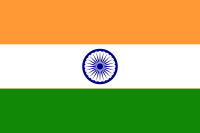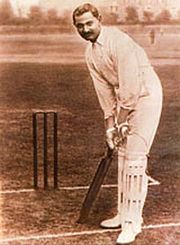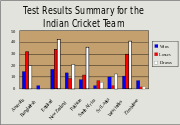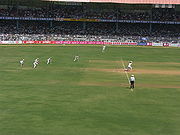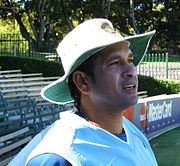
India national cricket team
Background Information
SOS Children made this Wikipedia selection alongside other schools resources. SOS mothers each look after a a family of sponsored children.
| India | |
|---|---|
| Test status granted | 1932 |
| First Test match | v England at Lord's, London, 25-28th June 1932 |
| Captain | M.S Dhoni- ODI & T20 Anil Kumble- Test |
| Coach | Gary Kirsten |
| Official ICC Test, ODI and T20I ranking | 2nd (Test), 4th (ODI) |
| Test matches – This year |
415 3 |
| Last Test match | v Australia at Adelaide Oval, Adelaide, January 24-28 2008 |
| Wins/losses – This year |
93/133 {{{win/loss record this year}}} |
|
As of March 15 2007 |
|
The Indian cricket team is an international cricket team representing India. It is governed by the Board of Control for Cricket in India, the cricket governing body in India. The Indian Cricket Team is currently the highest paid national sports team in the world (in terms of sponsorship).
Though the first match in India was recorded in 1721, when a group of sailors gathered to play in Western India, India's national cricket team didn't play their first Test match until 25 June 1932 at Lord's. They became the sixth team to play Test cricket. Traditionally much stronger at home than abroad, India proved weaker than Australia and England, winning only 35 of the 196 matches they played in their first fifty years. The team gained strength near the end of the 50-year period with the emergence of players such as Sunil Gavaskar and Kapil Dev and the Indian spin quartet. The Indian team has continued to be highly ranked since then in Test cricket and One Day Internationals. The team won the Cricket World Cup in 1983 and was runners-up in 2003. It also won the first World Twenty20 in 2007. The current team contains many of the world's leading players, including Sachin Tendulkar, Rahul Dravid, Sourav Ganguly and Anil Kumble, who hold numerous cricketing world records.
As of January 2008, the Indian team has played 414 Test matches, winning 22.46%, losing 32.13% and drawing 45.41% of its games. The team is ranked second in the ICC Test Championship rankings and fourth in the ICC ODI Championship rankings
History
The British brought cricket to India in the early 1700s, with the first cricket match being played in 1721. In 1848, the Parsi community in Mumbai formed the Oriental Cricket Club, the first cricket club to be established by Indians. After slow beginnings, the Europeans eventually invited the Parsis to play a match in 1877. By 1912, the Parsis, Hindus, and Muslims of Bombay played a quadrangular tournament with the Europeans every year. In the early 1900s, some Indians went on to play for the English cricket team. Some of these, such as Ranjitsinhji and KS Duleepsinhji were greatly appreciated by the British and their names went on to be used for the Ranji Trophy and Duleep Trophy-two of the major domestic tournaments in India. In 1911, an Indian team went on their first official tour of England, but only played English county teams and not the English cricket team. India was invited into The Imperial Cricket Council in 1926 and made its debut as a Test-cricket-playing-nation in 1932 led by CK Nayudu. The match was given Test status despite being only 3 days in length. The team was not strong in its batting at this point and went on to lose by 158 runs. The Indian team continued to improve throughout the 1930s and '40s but did not achieve an international victory during this period. The team's first series as an independent country was in 1948 against Sir Donald Bradman's Invincibles (a name given to the Australian cricket team of that time). Australia won the five-match series, 4-0.
India recorded their first Test victory against England at Madras in 1952. Later in the year, they won their first Test series, which was against Pakistan. They continued their improvement throughout the early 1950s with a series win against New Zealand in 1956. However, they did not win again in the remainder of the decade and lost badly to strong Australian and English sides. The next decade developed India's reputation as a team considered to be strong at home. Although they only won two series (both against New Zealand), they managed to draw home series against Pakistan, England and Australia.
The key to India's bowling in the 1970s were the Indian spin quartet - Bishen Bedi, E.A.S. Prasanna, Bhagwat Chandrasekhar and Srinivas Venkataraghavan. This period also saw the emergence of two of India's best ever batsmen, Sunil Gavaskar and Gundappa Viswanath. Indian pitches have had tendency to support spin and the spin quartet exploited this to create collapses in opposing batting lineups. These players were responsible for the back-to-back series wins in 1971 in the West Indies and in England, under the captaincy of Ajit Wadekar. Gavaskar scored 774 runs in the West Indian series while Dilip Sardesai's 112 played a big part in their one Test win.
The advent of One-Day International cricket in 1971 created a new dimension in the cricket world. However, India was not considerably strong in ODIs at this point and batsmen such as the captain Gavaskar were known for their defence-based approaches to batting. India began as a weak team in ODIs and did not manage to qualify for the second round in the first two editions of the Cricket World Cup. Gavaskar famously blocked his way to 36 not out off 174 balls against England in the first World Cup in 1975, India scored just 132 for 3 and lost by 202 runs.
In contrast, India fielded a strong team in Test matches and were particularly strong at home where their combination of stylish batsman and beguiling spinners where seen at their best. India set a then test record in the third Test against the West Indies at Port-of-Spain in 1976 when they chased 403 to win thanks to 112 from Vishwanath. This West Indian defeat is considered to be a watershed in the history of their cricket because it led to captain Clive Lloyd dispensing with spin altogether and relying entirely on a four man pace attack. In November 1976 the team established another record by scoring 524 for 9 declared against New Zealand at Kanpur without an individual scoring a century. There were six fifties, the highest being 70 by Mohinder Amarnath. The innings was the eighth instance in Test cricket where all eleven batsmen reached double figures.
During the 1980s, India developed a more attack minded batting line-up with stroke makers such as the wristy Mohammed Azharuddin, Dilip Vengsarkar and all-rounder Ravi Shastri prominent during this time. India won the Cricket World Cup in 1983, defeating the then favourites West Indies in the final, owing to a strong bowling performance. In spite of this the team performed poorly in the Test arena, including 28 consecutive Test matches without a victory. In 1984, India won the Asia Cup and in 1985, won the World Championship of Cricket in Australia. Apart from this, India remained a very weak team outside the Indian subcontinent. India's Test series victory in 1986 against England remained the last Test series win by India outside the subcontinent for the next 19 years. The 1987 Cricket World Cup was held in India. The 1980s saw Gavaskar and Kapil Dev (India's best all rounder to this date) at the pinnacle of their careers. Gavaskar made a Test record 34 centuries as he became the first man to reach the 10,000 run mark. Kapil Dev later became the highest wicket taker in Test cricket with 434 wickets. The period was also marked by an unstable leadership, with Gavaskar and Kapil exchanging the captaincy several times.
The addition of Sachin Tendulkar and Anil Kumble to the national side in 1989 and 1990 further improved the team. The following year, Javagal Srinath, India's fastest bowler since Amar Singh made his debut. Despite this, during the 1990s, India did not win any of its 33 Tests outside the subcontinent while it won 17 out of its 30 Tests at home. After being eliminated by neighbours Sri Lanka on home soil at the 1996 Cricket World Cup, the team underwent a year of change as Rahul Dravid, Saurav Ganguly, later to be become captains of the team, made their debut in the same Test at Lord's. Tendulkar replaced Azharuddin as captain in late 1996, but after a personal and team form slump, Tendulkar relinquished the captaincy and Azharuddin was reinstalled at the beginning of 1998. With the captaincy burden removed, Tendulkar was the world's leading run-scorer in both Tests and ODIs, as India enjoyed a home Test series win over Australia, the best ranked team in the world. After failing to reach the semifinals at the 1999 Cricket World Cup, Tendulkar was again made captain, and had another poor run, losing 3-0 on a tour of Australia and then 2-0 at home to South Africa. Tendulkar resigned, vowing never to captain the team again, with Sourav Ganguly appointed the new captain. The team was further damaged in 2000 when former captain Azharuddin and fellow batsman Ajay Jadeja were implicated in a match-fixing scandal and given life bans.
Since 2000, the Indian team underwent major improvements with the appointment of John Wright as India's first ever foreign coach. India maintained their unbeaten home record against Australia in Test series after defeating them in 2001. The series was famous for the Kolkata Test match, in which India became only the third team in the history of Test cricket to win a Test match after following on. Australian captain Steve Waugh labelled India as the "Final Frontier" as a result of his side's inability to win a Test series in India. Victory in 2001 against the Australians marked the beginning of a dream run for India under their captain Sourav Ganguly, winning Test matches in Zimbabwe, Sri Lanka, West Indies and England. The England series is also known for India's highest ODI run-chase of 325 runs at Lord's which came in the Natwest ODI Series final against England. In the same year, India were joint winners of the ICC Champions Trophy with Sri Lanka, and then went to the 2003 Cricket World Cup in South Africa where they reached the final only to be beaten by Australia. The 2003-2004 season also saw India play out a Test series in Australia where they drew 1-1 with world champions, and then win a Test and ODI series in Pakistan.
At the end of the 2004 season, India suffered from lack of form and fitness from its older players. A defeat in a following home Test series against Australia was followed by an ODI home series defeat against Pakistan followed by a Test series levelled 1-1. Greg Chappell took over from John Wright as the new coach of the Indian cricket team following the series, and his methods proved to be controversial during the beginning of his tenure. The tension resulted in a fallout between Chappell and Ganguly, resulting in Rahul Dravid being made captain. This triggered a revival in the team's fortunes, following the emergence of players like Mahendra Singh Dhoni, Suresh Raina, and the coming of age of players like Irfan Pathan and Yuvraj Singh. A thumping home series victory over Sri Lanka in 2005 and a level series with South Africa put India at 2nd place in the ICC ODI rankings. This was followed by a convincing ODI series win in Pakistan in early 2006 following a loss in the Test series, which gave India the world record of 17 successive ODI victories while batting second. Towards the middle of 2006 however, a 4-1 series loss in the West Indies gave rise to a slump in India's ODI form, while they achieved a 1-0 victory in the Test series that followed, giving them their first Test series victory in the Caribbean since 1971. India's ODI form, however, slumped further with a disappointing performance in the 2006 Champions Trophy and a drubbing in the ODI series in South Africa. This was followed yet again by an initial good performance in the Tests, giving India its first Test match win in South Africa, although they went on to lose the series 2-1. This Test series was marked by Ganguly's comeback to the Indian team.
The beginning of 2007 had seen a revival in the Indian team's ODI fortunes before the 2007 Cricket World Cup. Series victories against the West Indies and Sri Lanka, marked by the comeback of Ganguly, and strong form by Tendulkar, and the emergence of young attacking players like Robin Uthappa saw many pundits to tip India as a real chance to do well at the 2007 Cricket World Cup. However, defeats to Bangladesh and Sri Lanka saw India fail to reach the final eight.
India's traditional strengths have always been its line-up of spin bowlers and batsmen. Recently, it has a very strong batting lineup with Rahul Dravid, Sachin Tendulkar and Virender Sehwag all being selected to play for the ICC World XI in the 2005 " SuperTest" against Australia. In previous times, India was unique in that it was the only country to regularly field three spinners in one team, whereas one is the norm, and of the fifteen players to have taken more than 100 wickets, only four were pace bowlers from the last 20 years. However in recent years, Indian pace bowling has improved, with the emerging talents of Irfan Pathan, Munaf Patel and Sreesanth and many more playing in the national team.
In December 2006, it played and won its first ever Twenty20 international in South Africa, becoming the most recent Test team to play Twenty20 cricket. After winning the Test series against England in August 2007, Rahul Dravid stepped down as the captain of the team following which Mahendra Singh Dhoni was made the captain of the Twenty20 and ODI team. In September 2007, it won the first ever World Twenty20 held in South Africa, beating Pakistan by 5 runs in a thrilling final. India now is the most successful 20-20 team, measured by the winning percentage.
Governing body
The Board of Control for Cricket in India (BCCI) is the governing body over the Indian cricket team. The Board has been operating since 1929 and represents India with the International Cricket Council. It is amongst the richest sporting organizations in the world, it sold media rights to for India's matches in the next 4 years for 612 million US dollars. It negotiates India's sponsorships, its future tours and the selection of its players.
The International Cricket Council determines India's upcoming matches through its future tours program. However, the BCCI, with its influential financial position in the cricketing world, has often challenged the ICC's program and called for more tours between India, Australia, Pakistan and England which are more likely to earn more revenue as opposed to tours with Bangladesh or Zimbabwe. In the past, the BCCI has also come into conflict with the ICC in relation to sponsorships and the legitimacy of the ICC Champions Trophy.
Selection Committee
Selection for the Indian cricket team occurs through the BCCI's zonal selection policy, where each of the five zones is represented with one selector and one of the members nominated by BCCI as the Chairman of the Selection Committee. This has sometimes led to controversy as to whether these selectors are biased towards their zones.
The current chairman of Selection Committee is Dilip Vengsarkar. Bhupinder Singh Sr., Sanjay Jagdale, Ranjib Biswal and Venkatapathy Raju are the other members of the selection committee whose terms started in October 2006 and end in September 2008 with BCCI holding the rights for a one-year extension.
Tournament History
| ODI World Cup | Twenty20 World Cup | ICC Champions Trophy | Commonwealth Games | Asia Cup |
|---|---|---|---|---|
|
|
|
|
|
Team colours
When playing one-day cricket, the Indian cricket team has in recent years worn a sky blue shirt and pants. At present, the shirt also contains a diagonal tricolour design which reflects the Flag of India and the name of their main sponsor, Sahara. The one-day cap is also sky blue with the BCCI logo on the front, with a similar tricolour design on the brim of the cap.
With the advent of the World Series Cup in the 1970s, each team was to don a primary and secondary colour on their uniforms. The Indian team elected to wear light-blue as their primary colour and yellow as their secondary colour. Even during the 1999 Cricket World Cup the secondary colour on the Indian cricket team's clothing has been yellow. However, this has since been removed and replaced with the tricolour. However, in the past the Indian ODI outfits were changed to different shades of blue, mostly darker than the current, and the team donned dark blue during 1992, the current sky blue colour is more similar to that worn in the World Series Cup.
When playing first-class cricket, in addition to their cricket whites, Indian fielders sometimes wear a sunhat, which is dark blue and has a wide brim, with the BCCI logo in the middle of the front of the hat. Helmets are coloured similarly. Some players sport the Indian flag on their helmet. The current kit sponsor for the Indian team is Nike, Inc..
Test cricket grounds
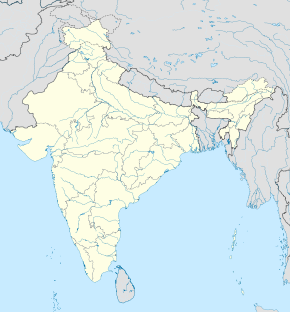
There are a number of world-renowned cricket stadiums located in India. Most grounds are under the administration of various State Cricket Boards as opposed to being under the control of the BCCI. The Bombay Gymkhana was the first ground in India to host a full-scale cricket match featuring an Indian cricket team. This was between the Parsis and the Europeans in 1877. Suitably therefore, the first stadium to host a Test match in India was the Gymkhana Ground in Mumbai in 1933, the only Test it ever hosted. The second and third Tests in the 1933 series were hosted at Eden Gardens and Chepauk. The Feroz Shah Kotla in Delhi was the first stadium to host a Test match after independence, being a draw against the West Indies in 1948, the first of a 5-Test series. Nineteen stadiums in India have hosted official Test matches. In recent times the building of world-class cricket grounds has increased in India, with multiple Test grounds occurring in the cities of Lucknow, Chandigarh, Chennai and Mumbai.
Eden Gardens in Kolkata has hosted the most Tests (34), and also has the largest capacity of any cricket stadium in the world, being capable of holding more than 100,000 spectators. Founded in 1864, it is one of the most historical stadiums in India, having hosted numerous controversial and historical matches. Other major stadiums in India include the Feroz Shah Kotla, which was established in 1883 and hosted memorable matches including Anil Kumble's ten wickets in an innings haul against Pakistan. For the last two years, the ground has been undergoing renovation.
The Wankhede Stadium is one of the newest world-class Indian cricket stadiums. Established in 1974 with a capacity of near 50,000. It has hosted 21 Test matches in its relatively short 32-year history. It was the unofficial successor of the Brabourne Stadium, which is also located in Mumbai. Mumbai is often considered the cricketing capital of India because of its fans and the talent it produces (see Mumbai cricket team) and thus the stadium regularly hosts major Test matches. The M. A. Chidambaram Stadium in Chepauk is also considered to be an important historical Indian cricket ground, established in the early 1900s it was the site of India's first Test victory.
The remainder of the Test stadiums are considered lesser compared to these major stadiums. The Gymkhana and Brabourne Stadiums are not used any more and have been replaced by the Wankhede. Similarly, the Barabati Stadium, Gandhi Stadium, K. D. Singh Babu Stadium, Lal Bahadur Shastri Stadium, Nehru Stadium, Sector 16 Stadium and University Ground have not hosted a Test match in the last 10 years.
| Stadium | City | Test matches |
|---|---|---|
| Eden Gardens | Kolkata | 35 |
| Feroz Shah Kotla | Delhi | 29 |
| M. A. Chidambaram Stadium | Chepauk, Chennai | 28 |
| Wankhede Stadium | Mumbai | 21 |
| Green Park (now Modi Stadium) | Kanpur | 19 |
| Brabourne Stadium | Mumbai | 17 |
| M. Chinnaswamy Stadium | Bangalore | 17 |
| Nehru Stadium | Chennai | 9 |
| Vidarbha C.A. Ground | Nagpur | 9 |
| Sardar Patel Stadium (Gujarat) | Naranpura, Ahmedabad | 8 |
| Punjab Cricket Association Stadium | Mohali, Punjab | 7 |
| Lal Bahadur Shastri Stadium | Hyderabad | 3 |
| Barabati Stadium | Cuttack | 2 |
| Bombay Gymkhana | Mumbai | 1 |
| Gandhi Stadium | Jalandhar | 1 |
| K. D. Singh Babu Stadium | Lucknow | 1 |
| Sawai Mansingh Stadium | Jaipur | 1 |
| Sector 16 Stadium | Chandigarh | 1 |
| University Ground | Lucknow | 1 |
Indian women's cricket team
The Indian women's cricket team has a much lower profile than the men's team. For all national women's cricket teams, the female players are paid much less their male counterparts, and the women's teams do not receive as much popular support or recognition as the men's team. The women's teams also have a less packed schedule compared to men's teams and play fewer matches. The Indian women's cricket team played its first Test match in 1976/7, when they drew with the West Indies in a six-match series.
The Women's Cricket World Cup was held in India in 1978 and featured 4 teams. Despite this, India failed to win either of their two matches. Their next appearance in the Test and ODI circuit was against Australia in 1984, in which the Test series was tied but the ODI series was lost in a humiliating whitewash.
The Indian women's cricket team has since picked up some form, reaching the finals in the last World Cup, but then losing to Australia. The Women's Asia Cup of 2005-06 was won by India, who beat Sri Lanka in the final. They also beat the West Indies in the 2004-05 season, winning the 5 ODI series 5-0. This year the Indian women's team lost to English women's team 4-0 in an ODI Series but beat them in the Twenty20 International and 1-0 in the Test series.
National records
Sachin Tendulkar is easily the batsman with the most national achievements. He holds the record of most appearances in both Tests and ODIs, most runs in both Tests and ODIs and most centuries in Tests and ODIs. The highest score by an Indian is the 309 scored by Virender Sehwag in Multan. It is the only triple century in Test cricket by an Indian. The team's highest ever score was a 705/7 against Australia in Sydney, 2004, while its lowest was 42 against England in 1974. In ODIs, the team's highest is 413/5 against Bermuda in the 2007 Cricket World Cup. In the same match, India set a world record of the highest winning margin of 257 runs in an ODI match.
India also has very strong bowling figures, with spin bowler Anil Kumble being a member of the elite group of 5 bowlers who have taken 500 wickets. In 1999, Anil Kumble emulated Jim Laker to become the second bowler to take all ten wickets in a Test match innings when he took 10 wickets for 74 runs against Pakistan at the Feroz Shah Kotla in Delhi. India's strength has traditionally been with its spin bowlers, which explains the records achieved by Anil Kumble and Bishen Singh Bedi.
Many of the Indian cricket team's records are also world records, for example Sachin Tendulkar's century tally (in Tests and ODIs) and run tally (in ODIs). Mahendra Singh Dhoni's 183 not out against Sri Lanka in 2005 is the world record score by a wicketkeeper in ODIs. Pankaj Roy and Vinoo Mankad's first wicket partnership of 413 is a world record for the first wicket, although it was close to being broken by Virender Sehwag and Rahul Dravid in 2006. The Indian cricket team also holds the record of 17 successful run-chases in ODIs, which ended in a dramatic match against the West Indies in May 2006, which India lost by just 1 run.
Current squad
| Name | Batting Style | Bowling Style | Domestic team | Zone | Contract grade | Shirt Numbers |
|---|---|---|---|---|---|---|
| Twenty20 and ODI Captain and Wicket Keeper | ||||||
| Mahendra Singh Dhoni | Right Hand Bat | - | Jharkhand | East | A | 7 |
| Test Captain and Spin Bowler | ||||||
| Anil Kumble | Right Hand Bat | Leg Break, Leg Break Googly | Karnataka | South | A | Test Only |
| Wicket-keepers | ||||||
| Dinesh Karthik | Right Hand Bat | - | Tamil Nadu | South | B | 1 |
| Opening batsmen | ||||||
| Sachin Tendulkar | Right Hand Bat | Leg Break, Leg Break Googly, Off Break | Mumbai | West | A | 10 |
| Sourav Ganguly | Left Hand Bat | Right Medium | Bengal | East | A | 21 |
| Virender Sehwag | Right Hand Bat | Off Break | Delhi | North | B | 2 |
| Wasim Jaffer | Right Hand Bat | Off Break | Mumbai | West | B | 14 |
| Gautam Gambhir | Left Hand Bat | Leg Break | Delhi | North | B | 5 |
| Robin Uthappa | Right Hand Bat | Right Medium | Karnataka | South | C | 77 |
| Specialist middle-order batsmen | ||||||
| Rahul Dravid | Right Hand Bat | Off Break | Karnataka | South | A | 19 |
| V. V. S. Laxman | Right Hand Bat | Off Break | Hyderabad | South | B | 22 |
| Suresh Raina | Left Hand Bat | Off Break | Uttar Pradesh | Central | C | - |
| Yuvraj Singh | Left Hand Bat | Slow Left Arm | Punjab | North | A | 12 |
| Rohit Sharma | Right Hand Bat | Off Break | Mumbai | West | D | 45 |
| Manoj Tiwary | Right Hand Bat | Off Break | Bengal | East | D | - |
| All-rounders | ||||||
| Irfan Pathan | Left Hand Bat | Left Medium Fast | Baroda | West | C | 63 |
| Yusuf Pathan | Right Hand Bat | Off Break | Baroda | West | D | 27 |
| Seamers | ||||||
| Ajit Agarkar | Right Hand Bat | Right Fast Medium | Mumbai | West | C | 68 |
| Joginder Sharma | Right Hand Bat | Right Medium Fast | Haryana | North | D | 23 |
| R. P. Singh | Right Hand Bat | Left Medium Fast | Uttar Pradesh | Central | B | 9 |
| Shanthakumaran Sreesanth | Right Hand Bat | Right Fast Medium | Kerala | South | B | 58 |
| Munaf Patel | Right Hand Bat | Right Medium Fast | Maharashtra | West | C | 48 |
| Zaheer Khan | Right Hand Bat | Left Medium Fast | Mumbai | West | A | 34 |
| Ishant Sharma | Right Hand Bat | Right Fast Medium | Delhi | North | D | N/A |
| Praveen Kumar | Right Hand Bat | Right Medium | Uttar Pradesh | Central | D | N/A |
| Spin Bowlers | ||||||
| Harbhajan Singh | Right Hand Bat | Off Break | Punjab | North | B | 35 |
| Ramesh Powar | Right Hand Bat | Off Break | Mumbai | West | C | 32 |
| Piyush Chawla | Left Hand Bat | Leg Break | Uttar Pradesh | Central | C | 11 |
| Murali Kartik | Left Hand Bat | Slow Left Arm | Railways | Central | D | 25 |
Coaching Staff
- Head Coach: Gary Kirsten
- Assistant Coach: Lalchand Rajput
- Bowling Coach: Venkatesh Prasad
- Fielding Coach: Robin Singh
- Fitness Trainer: Gregory King
- Physiotherapist: John Gloster
- Masseur: Ramesh Mane
- Computer Analyst: Subramanian Ramakrishnan
Captains
Twenty-eight men have captained the Indian cricket team in at least 1 Test match, although only 6 have led the team in more than 25 matches, and 5 have captained the team in ODIs but not Tests. India's first captain was CK Nayudu, who led the team in four matches against England, one in England in 1932 and a series of 3 matches at home in 1933/4. Lala Amarnath, India's fourth captain, led the team in its first Test match after Indian independence. He also captained the side to its first Test victory and first series win, both in a 3-match series at home against Pakistan in 1952/3. The Nawab of Pataudi was captain for 36 matches from 1961/2 to 1969/70, returning for a final 4 matches against West Indies in 1974/5.
India played its first ODI in 1974, under the captaincy of Ajit Wadekar. India won its first ODI under the captaincy of Srinivasaraghavan Venkataraghavan in the 1975 Cricket World Cup, against East Africa.
Sunil Gavaskar took over as Test and ODI captain in the late 1979s and early 1980s, leading India in 47 Test matches and 38 ODIs, winning 9 Tests and 14 ODIs. He was succeeded by Kapil Dev in the 1980s, who continued for 34 Test matches, including 4 victories. Kapil Dev led India to victory in 40 of his 74 ODIs in charge, including the 1983 Cricket World Cup.
India has had only four regular Test captains since Mohammad Azharuddin took charge in 1989. Azharuddin led the team in 47 Test matches from 1989/90 to 1998/9, winning 14, and in 173 ODIs, winning 89. He was followed by Sachin Tendulkar, who captained India in 25 Test matches and 73 ODIs in the late 1990s; Tendulkar was relatively unsuccessful as a captain, winning only 4 Test matches and 23 ODIs. He was replaced as ODI captain by Ajay Jadeja and then Sourav Ganguly; Ganguly became the regular captain in both forms of cricket in 2000. Ganguly remained captain for the first 5 years of the 2000s and was much more successful, winning 21 of his 49 Test matches in charge and 73 of his 141 ODIs. Rahul Dravid took over as Test captain in 2005. In his fourth full series in charge, he led India to victory in the West Indies, the first instance of India winning in the Caribbean in over 30 years. In September 2007, Mahendra Singh Dhoni was named as the new captain of the Twenty20 and ODI team after Dravid stepped down from the post. The current test captain is Anil Kumble.
Fan following
Cricket is the de facto national sport of India and has a very wide following among the population of India. As a result, stadiums are generally filled to capacity at matches on home soil. Due to large Indian diaspora in nations like Australia, South Africa, and England, a large Indian fan turnout is expected whenever India plays in each of these nations.
There have been a number of official fan groups that have been formed over the years, including the Swami Army or Bharat Army, the Indian equivalent of the Barmy Army, that were very active in their support when India toured Australia in 2003/2004. They are known to attribute a number of popular Indian songs to the cricket team.
Fan rivalry and cross-border tension has created a strong rivalry between the Indian cricket team and the Pakistani cricket team. This has made matches between these two nations the subcontinental above the Ashes. In tours between these two nations, cricket visas are often employed to accommodate for the tens of thousands of fans wishing to cross the border to watch cricket. This intense fan dedication is one of the major causes of the Indian Cricket Board's (BCCI) financial success.
However, there are downsides to having such a cricket-loving population. Many Indians hold cricket very close to their hearts and losses are not received well by the Indian population. In some cases, particularly after losses to Pakistan or after a long string of weak performances, there have been reports of player effigies being burnt in the streets and vandalism of player homes. In many cases, players have come under intense attention from the media for negative reasons, this has been considered as one of the reasons for Sourav Ganguly being left out of the Indian team. At times, when a match is surrounded by controversy, it has resulted in a debacle. For example, when India slid to defeat against Australia at Brabourne Stadium in 1969, fans began throwing stones and bottles onto the field as well as setting fire to the stands. A similar event occurred during the Cricket World Cup in 1996, where India were losing the semi-final to Sri Lanka at Eden Gardens. In this case, the fan behaviour was directed at the Indian team in disappointment at their lacklustre performance. An armed guard had to be placed at the home of captain Mohammad Azharuddin to ensure his safety. Indian fans have also been passionate in their following of Sachin Tendulkar, who has been commonly thought of as one of the best batsmen in the world. Glorified for the bulk of his career, a riot occurred in early 1999 in a Test against Pakistan at Eden Gardens after a collision with Pakistani paceman Shoaib Akhtar saw him run out, forcing police to eject spectators and the game to be played in an empty stadium. In more recent times, a string of low scores has resulted in continued impatience amongst fans. In front of his home crowd, against England, Tendulkar was booed by the crowd when he got out.
Often, fans quickly come to the defense of players who have been accused of wrongdoings or dropped from the team. In 2005, when Sourav Ganguly was dropped due to lack of form, Ganguly's home state of West Bengal erupted in protests. India later played a match against South Africa in Kolkata, West Bengal. The Indian team was booed by the crowd who supported South Africa instead of India in response to Ganguly's dropping. Similar regional divisions in India regarding selection have also caused protests against the team, with political activists from the regional Kalinga Kamgar Sena party in Orissa disrupting the arrival of the team in Cuttack for an ODI over the lack of an Orissan player in the team, with one player manhandling coach Greg Chappell. Similar treatment was handed to India's Marathi captain Sunil Gavaskar in the 1980s by Bengali crowds, with consecutive Tests in Calcutta requiring police intervention due to crowd rioting.
However, it should be noted that a successful string of results, victories against arch-rivals Pakistan or victory in major tournaments such as the World Cup are greeted with particular ecstasy from the Indian fans. In 2007 crowds at the One Day Series at Vadodara, Nagpur and Mumbai were seen to racially abuse Australian cricketer Andrew Symonds with monkey chants. After the BBCI initially denied the incident at Vadodara took place , further incidents at other grounds in the series proved the allegations correct.
